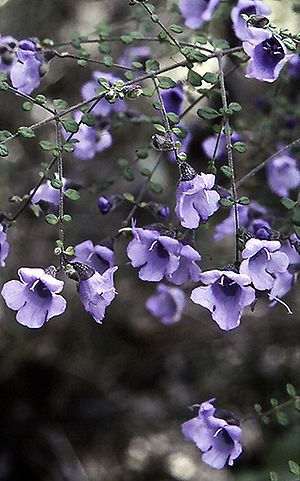Violet mint-bush facts for kids
Quick facts for kids Violet mint-bush |
|
|---|---|
 |
|
| In Conjola National Park | |
| Scientific classification | |
| Genus: |
Prostanthera
|
| Species: |
violacea
|
 |
|
| Occurrence data from AVH | |
The Prostanthera violacea, also known as the violet mint-bush, is a beautiful flowering plant. It belongs to the Lamiaceae family, which includes mints. This plant is special because it is endemic to a specific area: the south-eastern part of New South Wales in Australia. This means it naturally grows only there!
The violet mint-bush is a tall, thin shrub that smells very strongly, like mint. Its branches are covered in tiny hairs. Its leaves are mostly round, but they often look egg-shaped because their edges curl under. The flowers are usually a lovely mauve or bluish color, and they often have white tips.
About the Violet Mint-Bush
The violet mint-bush is a slender shrub that typically grows to be about 0.5–2 m (1 ft 8 in – 6 ft 7 in) (which is about 1.5 to 6.5 feet) tall. Its branches are covered with many tiny hairs, making them feel fuzzy.
The leaves of this plant are mostly round. However, their edges often roll inwards, making them look more like an egg shape. Each leaf is small, about 2–6 mm (0.079–0.236 in) (less than a quarter of an inch) long and wide. They grow on a tiny stalk called a petiole, which is only about 0.3–1 mm (0.012–0.039 in) long.
The flowers grow one by one where the leaves meet the stem. Each flower has small leaf-like parts called bracteoles that are about 1.5–2 mm (0.059–0.079 in) long, found just under the sepals. The sepals are like small green leaves that protect the flower bud. They are about 4–5 mm (0.16–0.20 in) long and form a tube about 1.5–2 mm (0.059–0.079 in) long. This tube has two parts, with the top part being about 2 mm (0.079 in) long.
The petals, which are the colorful parts of the flower, are usually mauve (a pale purple) or bluish. They often have white tips. These petals are about 7–8 mm (0.28–0.31 in) long. You can usually see these pretty flowers blooming in the spring.
How it Got its Name
The violet mint-bush was officially named Prostanthera violacea in 1810. It was named by a famous botanist (a scientist who studies plants) named Robert Brown (botanist, born 1773). He wrote about it in his important book called Prodromus Florae Novae Hollandiae et Insulae Van Diemen. This book was a big collection of descriptions of plants from Australia and Tasmania.
Where Does it Grow?
The violet mint-bush grows in forests, including special kinds of forests called rainforests. You can often find it in valleys or near streams and rivers. It lives along the coast and in the higher, flat areas (called tablelands) of south-eastern New South Wales.

